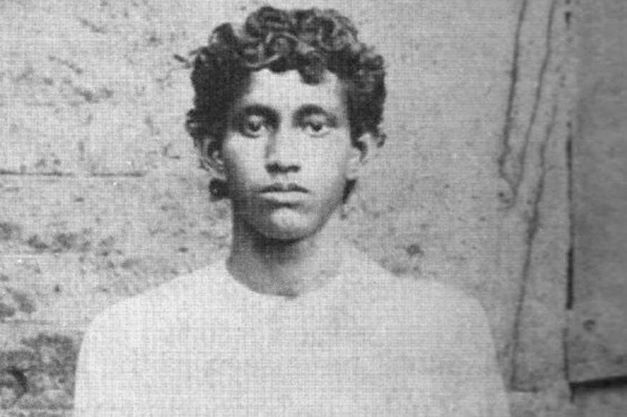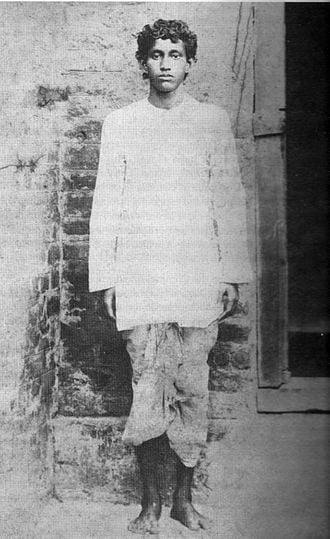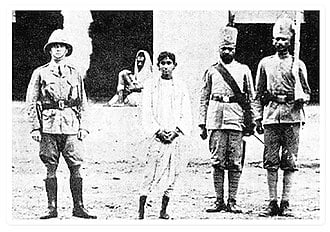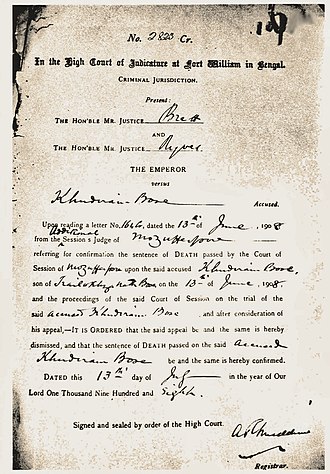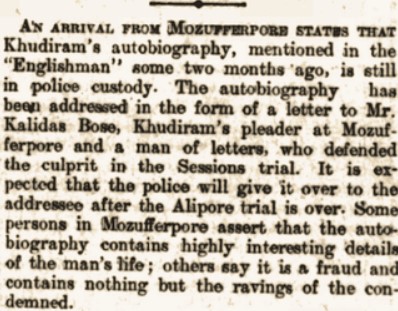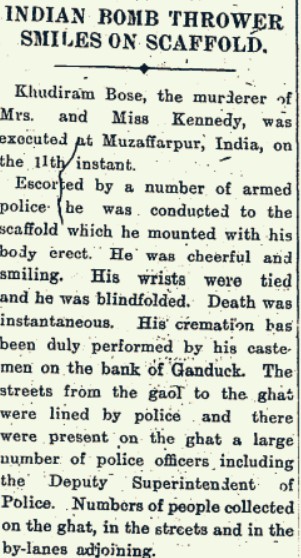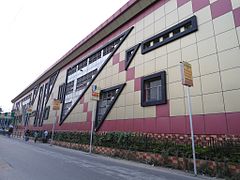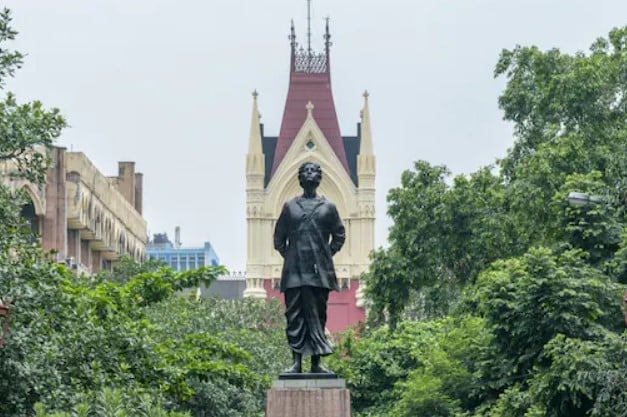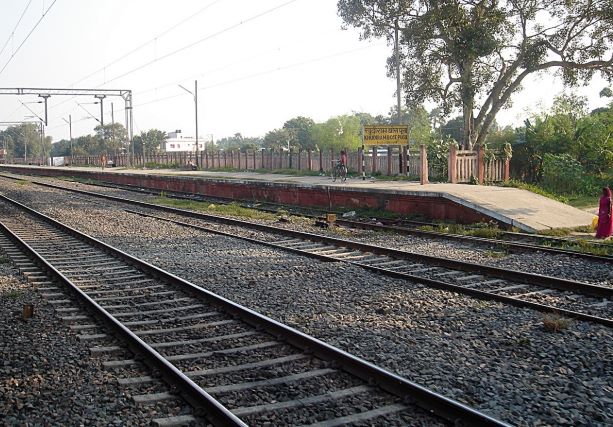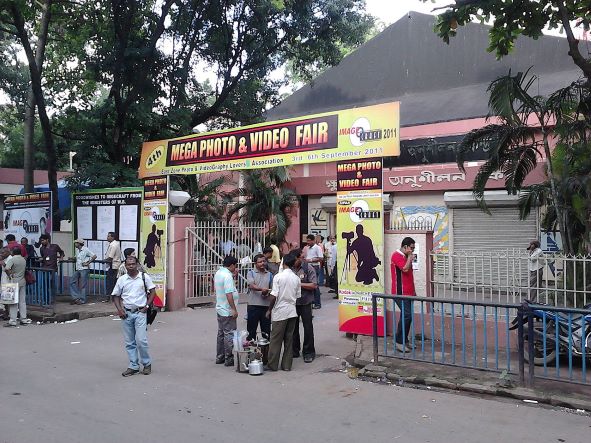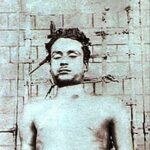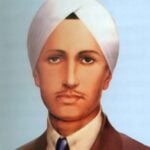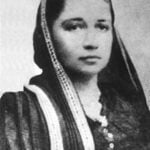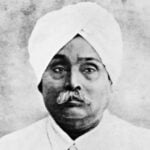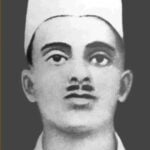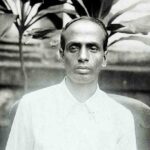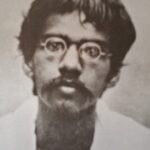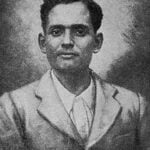Khudiram Bose Age, Death, Family, Biography & More
| Bio/Wiki | |
|---|---|
| Profession | Freedom Fighter |
| Famous for | Being one of the second youngest revolutionaries in India and the first Indian revolutionary in Bengal to be executed by the Britishers. |
| Physical Stats & More | |
| Eye Colour | Black |
| Hair Colour | Black |
| Personal Life | |
| Date of Birth | 3 December 1889 (Tuesday) |
| Birthplace | Mohobani, Midnapore, Bengal Presidency, India (present-day West Bengal, India) |
| Date of Death | 11 August 1908 |
| Place of Death | Muzaffarpur, Bengal Presidency, British India (present-day Bihar, India) |
| Age (at the time of death) | 18 Years |
| Death Cause | Execution by hanging [1]The Economic Times |
| Zodiac sign | Sagittarius |
| Nationality | British Indian |
| Hometown | Mohobani, Midnapore, Bengal Presidency, India (present-day West Bengal, India) |
| School | Tamluk's Hamilton High School, West Bengal [2]Legacy of Midnapore |
| Caste | Kayastha [3]Legacy of Midnapore |
| Relationships & More | |
| Marital Status (at the time of death) | Unmarried |
| Family | |
| Wife/Spouse | N/A |
| Parents | Father- Trailokyanath Bose (tehsildar in the Nerajol) Mother- Lakshmipriya Devi |
| Siblings | Sister- Aparupa Roy Brother-in-law- Amritalal Roy |
Some Lesser Known Facts About Khudiram Bose
- Khudiram Bose was an Indian revolutionary freedom fighter who belonged to the Bengal presidency. He was one of the youngest martyrs of the Indian independence movement who opposed the colonial rule in India. Khudiram Bose was involved in the Muzaffarpur Conspiracy Case and was executed along with his companion Prafulla Chaki by the British government. At the time of execution, Khudiram Bose was 18 years old, and he is regarded one of the youngest Indian revolutionaries in Bengal to be executed by the British government.
- Khudiram Bose and Prafulla Chaki planned the assassination of a British judge, Magistrate Douglas Kingsford. They threw bombs on a carriage, suspecting that Kingsford was in it, but he was seated in a different carriage. The carriage on which Khudiram Bose and Prafulla Chaki threw bombs resulted in the deaths of two British women. Soon before the arrest, Prafulla Chaki shot himself to death, and Khudiram Bose was detained by the Britishers for the murder of the two British women and was sentenced to death. Khudiram Bose was the second youngest revolutionary of India who was executed by the British government in India’s independence movement.
- Soon after the death of Prafulla Chaki and the execution of Khudiram Bose, Mahatma Gandhi condemned the violent ways of the young revolutionaries of India and stated in public interaction,
The Indian people will not win their freedom through these methods.”
Another Indian freedom fighter Bal Gangadhar Tilak defended the attempts of Khudiram Bose and Prafulla Chaki in his newspaper Kesari. This led to Bal Gangadhar Tilak’s arrest by the British colonial government.
- Khudiram Bose belonged to the Kayastha community of Bengal. He had three elder sisters, he was the fourth child of his parents. His parents had two sons before his birth, but they died soon after their birth. After the birth of Khudiram, his family members followed a traditional custom to save his life from dying at an early age and sold him to his elder sister for three handfuls of grains. This ritual was called Khud, and later, he acquired the name, Khudiram Bose.
- Khudiram Bose was six years old when his mother died. His father also died after a year. Soon, after the death of his parents, his elder sister brought him to her home at Hatgachha village, where his brother-in-law admitted him to the Tamluk’s Hamilton High School.
- In 1902 and 1903, Khudiram Bose, as a teenager, attended the public lectures that were delivered by Sri Aurobindo and Sister Nivedita at Midnapore to the revolutionary groups of freedom fighters.
- Soon, Khudiram Bose joined Anushilan Samiti and met Barindra Kumar Ghosh in Calcutta. At the age of fifteen, Khudiram Bose started participating in the Indian independence movements organised by Indian revolutionaries in Bengal and was often seen distributing pamphlets against the colonial rule in India. At the age of sixteen, reportedly, he started planting bombs near the police stations that aimed to kill the British government officials.
- Later, Anushilan Samiti decided to kill Kingsford. Soon, Khudiram Bose and Prafulla Chaki visited Muzaffarpur to keep an eye on the whereabouts of Kingsford. Hemchandra, an Indian revolutionary freedom fighter who was an expert in making bombs, gave them a bomb that was made up of 6 ounces of dynamite, a detonator, and a black powder fuse.
- Soon, Aurobindo Ghosh and Barindra Ghosh started visiting Muzaffarnagar regularly, which roused the suspicion of British police in Calcutta following which four men were assigned to guard the house of Magistrate Douglas Kingsford. During this time, Commissioner F. L. Halliday alerted the Superintendent of Police in Muzaffarpur, but his alerts were ignored.
- To keep an eye on the magistrate’s activities, the bogus name adopted by Khudiram Bose was Haren Sarkar, and Prafulla Chaki adopted Dinesh Chandra Roy, and they started living in an inn, which was run by Kishorimohan Bandyopadhyay in Muzaffarpur. They daily monitored the routine of the magistrate and keenly observed his activities. Within three weeks, both of them hid their real identities. The CID officer of Calcutta received a letter from Armstrong, the Superintendent of Muzaffarpur, that Khudiram Bose and Prafulla Chaki had not arrived in Muzaffarpur.
- On 29 April 1908, in the evening, Khudiram Bose and Prafulla Chaki pretended to be schoolboys and reached the place where they decided to execute their plan. They surveyed the Muzaffarpur park, which was opposite The British Club, where Magistrate Kingsford used to visit frequently. However, they were noticed by a British constable, and they soon aborted the plan.
- On the fateful day, Magistrate Douglas Kingsford and his wife were playing bridge with the wife and daughter of Pringle Kennedy, who was a British advocate. At 8:30 PM in the night, they all decided to go back home. Kingsford and his wife sat in a carriage that looked the same as the carriage of the wife and daughter of Pringle Kennedy. Khudiram and Prafulla Chaki threw the bombs in the carriage as soon the carriage reached the eastern gate of the compound of the European Club. The bomb made a huge explosion. The carriage was taken to Kingsford’s house where it was found that the two ladies sustained serious injuries. Kennedy’s daughter died within an hour of the blast, and his wife died on 2 May 1908.
- Soon after the blast, Khudiram Bose and Prafulla Chaki escaped the crime scene and went their own ways. Khudiram Bose reached the Waini station after walking 25 kilometres. At the station, he was suspected by two armed British policemen named Fateh Singh and Sheo Pershad Singh, when Khudiram Bose asked for a glass of water from a tea shop. The policemen suspected his exhausted appearance and dusty shoes. They enquired a couple of questions from him that made their doubt stronger. Soon, they decided to arrest Khudiram Bose following which he tried to escape again and started struggling with the two constables. During the scuffle, Khudiram Bose’s one of the two hidden revolvers fell down, and he immediately attempted to pull out his other revolver, but he was held tight from behind by one of the constables. Following his arrest, 37 rounds of pistol, Rs. 30 in cash, a railway map, and a rail timetable were recovered from Khudiram Bose by the police.
- Prafulla Chaki travelled long hours to escape the police arrest and was noticed by Trigunacharan Ghosh. Ghosh was already aware of the bomb blast, and he recognised Prafulla Chaki and decided to help him. Prafulla Chaki took a rest at Ghosh’s house and was sent to Kolkata by train. Ghosh arranged the train tickets to Chaki from Samastipur for Mokamaghat. Prafulla on his journey to Howrah struck in a conversation with Nandlal Banerjee, a sub-inspector in the Indian Imperial Police. Banerjee realised that Prafulla Chaki was the other revolutionary culprit of the bomb blast case of Muzaffarpur. At the Shipwright railway station, Prafulla Chaki got down to drink water. In the meantime, Ghosh sent a telegram to the Muzaffarpur police station and tried to detain Prafulla Chaki at the Mikamaghat police station. Prafulla tried to escape the scene but all was in vain, and in the end, he shot himself in his mouth with his last bullet.
- On 1 May 1908, when Khudiram Bose was detained by the police and was brought from the blast scene to the jail, then on his way, the Muzaffarpur railway station was crowded to see him who was merely 18 years old then. He was surrounded by a team of policemen. The district magistrate, Mr Woodman, looked after his case. On 2 May 1908, the English newspaper, The Statesman, wrote about Khudiram Bose and his trials. It wrote,
The Railway station was crowded to see the boy. A mere boy of 18 or 19 years old, who looked quite determined. He came out of a first-class compartment and walked all the way to the phaeton, kept for him outside, like a cheerful boy who knows no anxiety…..on taking his seat the boy cheerfully cried ‘Vandemataram’.
- Before his execution by hanging, Khudiram Bose revealed that although he was naughty in childhood, he inclined towards patriotism when he entered Midnapore Collegiate School.
I was naughty in my childhood, But after I entered Midnapore Collegiate School a change overtook me.” – Khudiram Bose
- During his first court proceeding, Khudiram Bose was not aware that his companion Prafulla Chaki was dead. In his statement to the district magistrate, Khudiram Bose took the responsibility for his actions and assassination. Soon, the body of Prafulla Chaki reached Muzaffarpur and was identified by Khudiram Bose. The details of the Prafulla Chaki’s encounter were provided by sub-inspector Bannerjee. However, the British authorities still not believed Khudiram Bose and Bannerjee, and they decapitated Prafulla’s body and send it to Calcutta for further enquiries and confirmations.
- Khudiram Bose’s court proceedings began on 21 May 1908, and the jury included Judge Corndoff, Nathuni Prasad, and Janak Prasad. Mrityunjay Chakraborty and Kishorimohan Bandopadhyay were also tried in the court along with Khudiram Bose. These two people helped and accommodated Khudiram Bose during his revolutionary mission. During the first trial, Mrityunjay Chakraborty died, and Kishorimohan Bandopadhyay was tried separately. The lawyers who took up Khudiram’s defence were Kalidas Basu, Upendranath Sen, and Kshetranath Bandopadhyay. Later, they were joined by Kulkamal Sen, Nagendra Lal Lahiri, and Satischandra Chakraborty. His case was fought by these lawyers without any fees. The prosecutors of the British government were Mannum and Binod Bihari.
- The second proceeding of Khudiram Bose took place on 23 May 1908. He resubmitted his appeal to the magistrate E.W. Bredhowd, and in his statement, Khudiram Bose stated that he was not involved in the mission. The statement was forcefully signed by Khudiram Bose at the request of his lawyers. It was decided by the jury of the case that the verdict would be announced on 13 June 1908; however, the judges and the prosecutors received an anonymous threatening letter on the same day. The letter mentioned,
One more bomb coming for them from Kolkata and that henceforth. it will be the Biharis, and not the Bengalis, who are going to kill them.”
- The letter assured British judges and prosecutors that there were other masterminds behind the Muzaffarpur Conspiracy Case other than Khudiram Bose. Later, it was expected that the jury would deliver a sentence other than death to Khudiram Bose because of his age. But, the death sentence was pronounced by the Judge.
- Soon after the verdict, Khudiram Bose responded with a smile. The judge asked him if he had understood the meaning of the death sentence to which Khudiram nodded. The judge further asked him if he had anything else to say. Khudiram then replied that if he was given more time, he would teach the judge how to make bombs. Khudiram replied to the judge,
Yes, I do and my lawyer said that I was too young to make bombs. If you allow me some time before I’m taken away from here, I can teach you the skills of making bombs too.”
Soon, Khudiram was sent out of the courtroom by the British police.
- The legal system allowed Khudiram Bose to appeal again within seven days against the last verdict. However, he denied the same. Later, he was persuaded by his lawyers and counsellors that if he would appeal for the life sentence instead of being hanged then he would have the chance to serve his country again. Finally, Khudiram Bose agreed with his lawyers and appealed against the verdict.
- On 8 July 1908, the next court proceeding took place. Narendra Kumar Basu was the defence lawyer of Khudiram. The defence lawyer challenged the verdict of the session court under article 164 of the penal code and stated that Mr Woodman was not a first-class magistrate, and Khudiram, as an accused, was required to declare his statement in front of a first-class magistrate. It was mentioned by Khudiram’s lawyer that the accused was not told the actual position of the magistrate in the first session of court proceedings. It was stated by the defence lawyer that under article 364, the accused must be questioned in his mother tongue, but Khudiram was questioned in English. In addition to this, the defence lawyer mentioned that the signature of Khudiram was supposed to be taken on the same day of the proceedings, but Khudiram signed the statements a day after the proceeding and in front of another additional magistrate. Narendra Kumar Basu mentioned in the last that Prafulla Chaki was a stronger accused in the bomb blast case. Basu stated,
Prafulla aka “Dinesh” (the name used in the trial) was stronger than Khudiram was, and he was the bomb expert among the two of them. Thus, it is highly likely that the actual thrower of the bomb was “Dinesh”. Further, Prafulla’s suicide on the verge of capture only reinforces the possibility of his being the actual thrower of the bombs.”
- Soon after the proceeding, the judges announced that the final verdict of the case would be passed on 13 July 1908. On the judgement day, the legal arguments made by Narendra Kumar Ghosh were believed to be technically sound, but the statements made by Khudiram Bose were considered the foundations for the final verdict as he was the only survivor of the two accused. The judges announced and confirmed the death sentence for Khudiram Bose and dismissed the appeal of the accused.
- On 11 August 1908, at sharp 6 AM, the prison was surrounded by a huge crowd to support Khudiram Bose and his revolutionary activities. According to some news reports, the people were spotted holding flower garlands in their hands. Upendranath Sen, a journalist of the Bengali newspaper Bengalee who was also a lawyer and was close to Khudiram Bose, reached the death sentence venue in a car with all the necessary funeral arrangements at 5 AM. The funeral procession of Khudiram Bose went across the city after his execution. The procession was tightly guarded by police guards, who were trying to hold back the crowd. The people were spotted throwing flowers on Khudiram’s body.
- On 12 August 1908, the Amrita Bazar Patrika, published an article on the life sacrifices of Khudiram Bose on the next day of execution. The newspaper wrote the headline-
Khudiram’s End: Died cheerful and smiling” – Khudiram’s execution took place at 6 a.m. this morning. He walked to the gallows firmly and cheerfully and even smiled when the cap was drawn over his head.”
The Empire, an Anglo-Indian newspaper wrote,
Khudiram Bose was executed this morning…It is alleged that he mounted the scaffold with his body erect. He was cheerful and smiling.”
On 26 May 1908, a Marathi newspaper, The Kesari, published,
Neither the Jubilee murder of 1897, nor the reported tampering of the Sikh regiments had produced so much commotion, and the English public opinion seems inclined to regard birth of the bomb in India as the most extraordinary event since the mutiny at 1857.”
- Soon after the death of Khudiram Bose, a Bengali poet named Kazi Nazrul Islam wrote a poem on Khudiram in his honour. Khudiram Bose became so popular after martyrdom that the people of Bengal started wearing a type of dhoti with ‘Khudiram’ written on its side, and the young revolutionaries and school-going boys started wearing dhotis like Khudiram Bose.
- In 1965, an undergraduate college named Khudiram Bose Central College was established in Calcutta. This college is affiliated with the University of Kolkata and offers courses in arts and commerce.
- Later, a metro railway station named Shahid Khudiram Station was named near Garia in Kolkata to honour the sacrifices of Khudiram Bose during India’s struggle for freedom.
- A hospital named Shahid Khudiram Bose Hospital was established by the Government of India on BT Road near Municipality park. A statue of him was erected in Kolkata by the state government.
- After the independence of India, the Waini station was renamed Khudiram Bose Pusa Station by the Government of India.
- Thereafter, the Muzaffarpur Jail, where Khudiram Bose was hanged on 11 August 1908, was named Khudiram Bose Memorial Central Jail in the memory of Khudiram Bose. Khudiram Anushilan Kendra was established by the Government of India in his memory. This Kendra is located near the Netaji Subhash Chandra Bose Indore Stadium in Kolkata.
- Later, a University named Sahid Khudiram Siksha Prangan was established for postgraduate studies. This campus is also known as Alipore Campus and is affiliated with the University of Calcutta, Kolkata. Another college named Saheed Khudiram College at Kamakhyaguri, Alipurduar, West Bengal was established by the Government of India.
- In 2017, a film titled ‘Main Khudiram Bose Hun’ was released, which was based on the life journey of Khudiram Bose. Kanishk Kumar Jain portrayed the character of Khudiram Bose in the film.
References/Sources:

